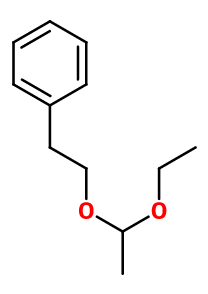Hyacinth Body®
Synthétique
Floral > Rosy > Green > Mushroom > Metallic

Crédits photo: ScenTree SAS
Other names :
Emeraldine® ; Verdilyne® ; Verotyl® ; 2-(1-ethoxyethoxy)ethylbenzene ; Acetal E ; Acetaldehyde ethyl 2-phenylethyl acetal ; Efetaal ; 1-ethoxy-1-(2-phenylethoxy)-ethane ; Ethyl phenethyl acetal ; Nasturtium acetal ; Verdilyn ; Verotyl ; Vertocinth
Volatility :
Heart
Uses in perfumery :
Hyacinth Body® is used in light and heavy floral notes, in hyacinth, mango, green and violet leaf notes. Gets on well with candle base and in rinsed products.
Natural availability :
Hyacinth Body® is not available in its natural state.
Year of discovery :
Data not available.
Other comments :
Data not available.
Price Range :
€€€
Stability :
Stable in perfumes and diverse functional bases

Crédits photo: ScenTree SAS
- Molecular formula :
- C12H18O2
- Molecular Weight :
- 194,27 g/mol
- Density :
- 0,96
- Flash Point :
- >94°C
- Fusion Point :
- Donnée indisponible.
- Appearance :
- Pale yellow liquid
- Log P :
- 3,3
- Boiling Point :
- Donnée indisponible.
- Detection Threshold :
- Donnée indisponible.
Synthesis route :
Hyacinth Body® can be synthesized by reacting Phenyl Ethyl Alcohol with ethyl vinyl ether, in the same molar proportions, and in the presence of a cation exchanger resin.
Synthesis precursor :
Hyacinth Body® is not a precursor to the synthesis of another compound of olfactory interest.
Isomerism :
Hyacinth Body® has an asymmetric carbon. It is however its racemic mixture that is used in perfumery. Scentenal® is a constitutional isomer of Hyacinth Body®. Nevertheless, its smell is more marine and less floral.
- EINECS number :
- 219-868-9
- FEMA number :
- Donnée indisponible.
- JECFA number :
- Donnée indisponible.
- FLAVIS number :
- 06.080
- Allergens :
- This ingredient does not contain any allergen.
- IFRA :
- This ingredient is not restricted
To learn more about IFRA's standards : https://ifrafragrance.org/safe-use/library
ScenTree is solely responsible for the information provided here.

